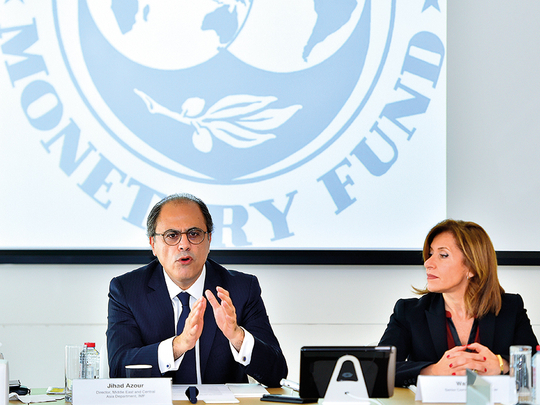
Dubai: Slowing of economic activity across GCC countries in 2017 reflects a deeper than-expected slowdown relative to the forecast in the October 2017, the International Monetary Fund said in its latest Regional Economic Outlook.
In the GCC, overall GDP growth fell by 0.2 per cent last year, with Saudi Arabia seeing its first economic contraction since 2009. This mostly reflected the effect of the Opec+ oil production cuts, which more than offset the continued recovery in non-oil growth in most countries.
“Relative to the forecasts in the October WEO [World Economic Output], with the pickup in oil prices, prospects for oil exporters have improved somewhat with a small downward revision to 2018 growth and a positive revision to 2019 growth. Growth outlook has improved on global economic recovery, but the region as a whole has not fully benefited from it,” said Jihad Azour, the IMF’s Director of the Middle East and Central Asia Department of the IMF.
The UAE economy is projected to grow at a more modest pace of 2 per cent compared to the projections of 3.4 per cent made in last October. The country’s economic growth has been revised downwards to 0.5 per cent in 2017 from a projected 1.3 per cent in October last year. For 2019, the country’s GDP is projected to grow at 3 per cent.
Revised forecast
In Saudi Arabia, growth is projected to resume this year, rising to 1.7 per cent from a contraction of 0.7 per cent in 2017. Growth in 2019 is expected to rise slightly to 1.9 per cent as oil output increases, with the assumed expiration of the Organisation of the Petroleum Exporting Countries (Opec) Plus production cut agreement. For Saudi Arabia, the forecast has been revised up from the October WEO by 0.6 and 0.3 percentage points for 2018 and 2019, respectively.
Latest IMF numbers for 2017 show Saudi Arabia and Kuwait had negative growth of -0.7 per cent and -2.5 per cent respectively, while Qatar had a 2 per cent real GDP growth, overall GCC GDP growth was in negative at -0.2 per cent.
Qatar’s economy is projected to grow at 2.6 per cent and 2.7 per cent, in 2018 and 2019, respectively. Kuwait is projected to recover from recession and report a positive growth of 1.3 per cent in 2018 followed by 3.8 per cent growth in 2019.
In the UAE, where weak consumer and investor confidence dampened domestic demand, non-oil GDP growth in 2017 was softer than that of the previous year. In Bahrain, stronger non-oil growth — supported by GCC-funded projects and robust financial and hospitality sectors — more than offset weaker oil output.
Sharp slowdown
According to the IMF, in 2017, GDP growth oil exporters from the Middle East Africa and Pakistan region was 1.7 per cent, much weaker than the 5.4 per cent in 2016. “The sharp slowdown reflected the impact of oil production cuts agreed to in the Opec+ deal. However, oil exporters continued to see an ongoing and broad-based recovery in non-oil activity, partly as the result of slower fiscal adjustment,” said Azour.
As the Opec+ agreement expires and oil production recovers, growth is projected to accelerate this year and next. Nevertheless, at annual 3.6 per cent over 2019-23, the medium-term growth in oil-exporting countries is projected to remain well below its pre-2014 oil shock levels.
With growth estimated to have bottomed out in 2017, the overall outlook is little changed relative to October. Economic activity is projected to accelerate in 2018—19, but to remain low relative to pre-2014 levels over the medium term. Specifically, for the regional oil exporters, overall growth is projected at 2.8 per cent this year and 3.3 per cent in 2019 compared to 3 per cent and 2.7 per cent projected in October.












